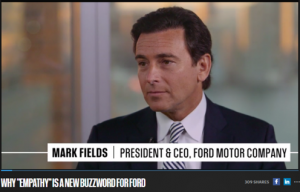Customer experience culture: Ford’s perspective
A customer-centric culture doesn’t happen simply because it’s on a presentation slide as a strategic pillar. It’s a topic that risks being swamped by platitudes and theory so I was curious to hear Mark Fields, President and CEO of Ford Motor Company, talk about what the transformation to a customer experience culture looks like in reality.
The size of the organisation is irrelevant but I wanted to share some of his thoughts from a recent FastCompany interview . There are a number of characteristics that we can all identify with, learn from or at least be reassured that we’re heading in the right direction. 
Firstly, Mr Fields emphasises the need to be very clear about who you are. In Ford’s case they have been a manufacturing company. With connectivity and the internet-of-things creating huge possibilities they are now moving through being a technology business to a user-experience and mobility company.
Transformation can be a scary word for many employees. Ford’s approach therefore is to be clear that it’s not about moving from an old business to a new business, they are moving to a bigger and better business. And that will need to include winning over everyone in the supply chain and the franchised sales and service teams too.
Wherever they work, colleagues are encouraged to challenge custom, to question tradition and to not take anything for granted. Having worked for large corporates who frowned upon seeking and sharing learnings from outside the sector, that alone is refreshing to hear.
Ford reassures its people they wont get penalised for trying things, knowing that some will fail and some will succeed. It might be in product design, customer engagement or stakeholder management. It might be in new methods of customer feedback or in innovative ways to bring to life what it’s really like to be a customer. But, so the approach goes, you learn whether you win or lose.
Virgin Atlantic has a similar philosophy. Google Glass had certain benefits but the airline wanted to see how else it could make the lives of its employees better. With wearable technology, they knew it would take some time for a critical mass of customers to use it but they found real advantages for their operations team. As a result Virgin’s dispatchers now use smart watches to improve the turn-around efficiencies of aircraft.
On technology, with all the data, sensors and processing power we now have, Mark Fields is clear. He wants Ford to be known for being an automotive and mobility company but is very aware of the risk of falling into the trap of technology for technology sake. His answer is to think about the experiences first then find the best technology to deliver them. It’s the same principle with customer measurement; get the experience right first and the metrics will look after themselves.
It means that at Ford, there is a new and relentless focus on empathy. They are using ethnography to better understand their customer personas, their interactions and how the products and services are used. It gives greater certainty that the changes being made are the right ones.

There are no shortcuts on the road to cultural change
Cultural change is never quick. After all, it’s a state of mind and isn’t something that can be project managed. The right changes will not happen if the organisation is not open to the very idea of customer-centricity. So to have the boss eulogising about the focus on customer experiences suggests the chances of longevity are good.
That said, Ford will be very aware that changing a culture takes years. Back in 1909, customer-centricity had a different meaning. To improve productivity and make the car affordable to the masses, the company’s founder Henry Ford restricted customers’ colour choice to black. Those with memories of more recent times may recall Ford’s 1990s advertising campaign in which Brian May’s rousing soundtrack promised “Everything we do is driven by you”. Albeit a strapline with an inward-looking perspective, it was well-intended.
So while first challenge is to have the right mindset, it doesn’t stop there. The key is then to keep up the momentum, to make sure everyone understands what that frame of reference is, why it’s important and what it means for them on a day-to-day basis.
Ford is not alone in having such a philosophy and Mark Fields isn’t the first CEO to say they are customer-centric. Time will tell. To succeed, I believe an organisation must combine a deep understanding of its customers with highly motivated employees. But most important of all is that the business must also nurture a culture where those insights and enthusiasm are allowed the opportunity to prosper. At best, it will drive a business forward as it adapts to the changing world. At worst, it will stop it being from standing still and being overtaken.
Thank you for reading the blog, I hope you found it interesting and thought-provoking. I’d love to hear what you think about the subject so please feel free to add your comments below.
I’m Jerry Angrave, founder of Empathyce and an ex-corporate customer experience practitioner. I’m now a CX consultant and an official trainer for the CXPA’s professional qualification to be a CCXP. If you’ve any questions about improving customer experience or CX professional development do please get in touch. I’m on +44 (0) 7917 718 072 or on email I’m [email protected].
To subscribe for future posts please send an email to [email protected]


Leave a Reply
Want to join the discussion?Feel free to contribute!